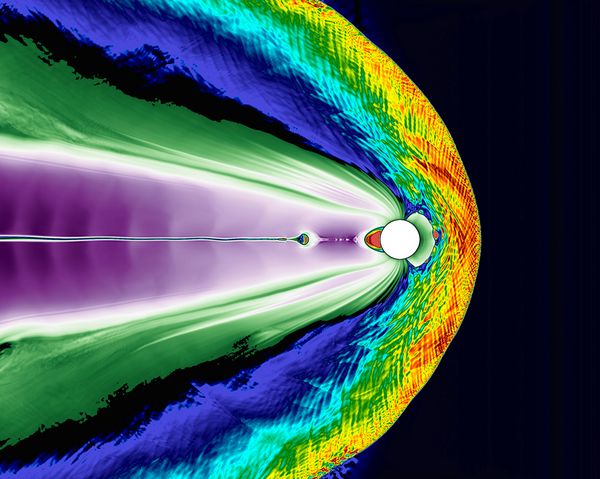ASTROPHYSICS
Global Kinetic Modelling of Space Weather – With Extreme Scalability (VLASIATOR)
Principal Investigator:
Minna Palmroth
Affiliation:
Earth Observation Finnish Meteorological Institute, Helsinki (Finland)
Local Project ID:
PP14112573
HPC Platform used:
Hazel Hen of HLRS
Date published:
Space weather is an increasingly important aspect for our technology-dependent society. Modelling space weather is difficult, however, a Finnish team has succeeded in something that was said to be impossible: an accurate simulation of the large-scale near-Earth space environment. PRACE Tier-0 grant from Hazel Hen (HLRS, Stuttgart) both allowed the Vlasiator team to discover new space physics phenomena, and significantly helped in the acceptance of the second European Research Council grant awarded to the project PI in fall 2015.
Space weather is caused by the solar wind, a stream of charged particles – or plasma – carrying the solar electromagnetic field. Dynamic variations of the solar wind can cause extended periods of major disturbances on ground and space, affecting many technological systems, such as power grids and global navigation systems.
Simulating space weather is important, as only accurate models will eventually bring space weather forecasts to aid our technology-dependent world. Simulations also provide a context to spacecraft data. However, space is in many ways the final frontier of computational physics. The simulation box should cover millions of kilometres, and the required resolution – in the best possible case – should be only a few kilometres.

Vlasiator is developed with a European Research Council Starting grant (2008-2013). It is a unique large-scale global space weather model, which can accurately describe plasmas to a degree that currently cannot be self-consistently described by the existing global space weather simulations. Due to the multi-dimensional approach in ion scales, Vlasiator’s computational challenges are immense requiring high performance computing techniques to allow massively parallel computations.
During this PRACE grant period, Vlasiator has seen a large set of technical improvements, allowing almost linear scaling up to 100,000 cores, and enabling more comprehensive analysis. Vlasiator offers in-depth studies of magnetospheric processes such as magnetic reconnection, and particle acceleration.
Normally in space physics, upstream solar wind phenomena cause downstream dynamical variations, while downstream phenomena have not been thought to cause upstream phenomena. As a surprise, the latest PRACE Tier-0 grant enabled runs showing that some phenomena downstream can lead to perturbations of the shape of the shock that encompasses the Earth’s magnetic domain. This discovery is confirmed by in-situ spacecraft observations and is the subject of an article submitted to a peer-reviewed journal.
Magnetic reconnection is one of the most important processes in plasmas, transforming magnetic energy to kinetic energy by accelerating particles. With the new runs, the Vlasiator team is able to, for the first time in the world, look at the reconnection process simultaneously in the entire Earth’s magnetic domain, and to witness dayside reconnection driving nightside reconnection. This reveals a rich playground of collective phenomena that cannot be interpreted by spacecraft observations only, nor with earlier simulation methods. These results have been presented in major international conferences, and will be submitted to a peer-reviewed journal in 2016.

Figure 1: Solar wind flows to the simulation box from the right. Earth’s magnetic domain – the magnetosphere – is like a rock in the stream, and a shock forms to encompass the magnetosphere. The color-coding shows the density of plasma, indicating that the shock packs plasma in front of the magnetosphere. The round features travelling along the magnetopause that separates the magnetosphere from the shock are representations of magnetic reconnection on the dayside, while in the nightside other blobs of plasma are forming due to the same phenomenon. This is the first run ever showing both dayside and nightside reconnection in ion scales in the same simulation box.
Copyright: FMI, HelsinkiScientific Contact:
Prof. Minna Palmroth
Programme Head, Earth Observation Finnish Meteorological Institute
P.O.Box 503, FIN-00101 Helsinki
e-mail: minna.palmroth [@] fmi.fi